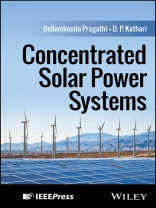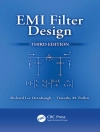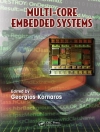Follow the performance assessment tools and methods currently used for concentrated solar power technology (CSP) in this unique, single source overview
The search for renewable energy sources and methods for harnessing them is perhaps the most significant challenge of the twenty first century, which faces the potentially existential crises of global climate change. Concentrated solar power, or CSP, has the potential to revolutionize energy production. Its integration of thermal energy and its capacity to work with traditional power generation cycles make it an ideal tool for a newly sustainable world.
Concentrated Solar Power Systems is an advanced-level book offering both theoretical and practical perspectives on CSP. Its thorough overview of this technology includes the foundational scientific principles, system design and development, and growing applications. It offers a one-stop source for the performance assessment tools and methods currently deployed in the area of concentrated solar power.
Readers will also find:
- Case studies throughout showing CSP harnessed to meet real energy needs
- Detailed discussion of topics including site selection, feasibility analysis, environmental assessments, and more
- Analysis of specific technologies including linear Fresnel reflectors, parabolic troughs, concentrating photovoltaic systems, and many others
Concentrated Solar Power Systems is ideal for students and researchers involved or interested in the design, production, development, optimization, and application of CSP technology.
สารบัญ
About the Authors xv
Preface xvii
Acknowledgments xix
1 Conventional Energy Sources 1
1.1 Energy Resources and Their Potential 2
1.1.1 Oil 2
1.1.2 Natural Gas 2
1.1.3 Coal 3
1.1.4 Hydropower 5
1.1.5 Nuclear Energy 6
1.2 Need for Renewable Energy Sources 10
1.3 Potential Renewable Energy Sources (RES) for Power Generation 12
1.3.1 Solar Energy 12
1.3.2 Wind Energy 12
1.3.3 Biomass Energy 13
1.3.4 Hydropower Plants 14
1.3.5 Hydropower Project Classification 14
1.3.6 Geothermal Energy and Its Potential in India Wave Energy 15
1.3.7 Wave Energy 16
1.3.8 Tidal Energy 16
1.3.9 Off-Grid Renewable Power 17
1.3.9.1 Approaches to Concentrating Solar Power (CSP) 18
1.4 Concentrating Optics 18
1.5 Limits on Concentration 20
1.6 Conclusion 21
References 21
2 Measurement and Estimation of Solar Irradiance 23
2.1 Introduction 23
2.2 Parabolas and Paraboloids 24
2.2.1 Practical Factors Reducing Concentration 29
2.2.1.1 Specularity Error 29
2.2.1.2 Surface Slope Error 29
2.2.1.3 Shape Error 30
2.2.1.4 Tracking Error 30
2.2.1.5 Combinations of Errors 30
2.2.1.6 Cosine Losses and End Losses 30
2.2.1.7 Focal Region Flux Distributions 31
2.2.1.8 Prediction of Focal Region Distributions 31
2.2.1.9 Losses from Receivers 33
2.2.1.10 Radiative Losses 34
2.2.1.11 Convection Losses 36
2.2.1.12 Conduction Losses 37
2.2.1.13 Energy Transport and Storage 37
2.3 Power Cycles for Concentrating Solar Power (CSP) Systems 37
2.3.1 Steam Turbines 37
2.3.2 Organic Rankine Cycles 40
2.3.3 Stirling Engines 40
2.3.4 Brayton Cycles 41
2.3.5 Concentrating Photovoltaics 41
2.3.6 Others 42
2.4 Energy Analysis and the Second Law of Thermodynamics 43
2.4.1 Heat Exchange Between Fluids 45
2.4.2 Optimization of Operating Temperature 45
2.4.3 Optimization of Aperture Size 47
2.4.4 Solar Multiple and Capacity Factor 49
2.4.5 Predicting Overall System Performance 51
2.4.6 Economic Analysis 55
2.4.7 Stochastic Modeling of CSP Systems 58
2.5 The Structure of the Sun 59
2.5.1 The Solar Irradiance Spectrum 59
2.5.2 Factors Affecting the Availability of Solar Energy on a Collector Surface 60
2.6 Radiation Instruments 61
2.6.1 Solar Irradiance Components 61
2.6.2 Instruments Used 61
2.6.3 Detectors for Measuring Radiation 61
2.6.4 Measuring Diffuse Radiation 61
2.7 Why Solar Energy Estimation? 62
2.8 Mathematical Models of Solar Irradiance 62
2.8.1 CPCR2 (Code for Physical Computation of Radiation, 2 Bands) Model 63
2.9 Diffuse and Global Energy 63
2.10 REST2 (Reference Evaluation of Solar Transmittance, 2 Bands) Model 64
2.11 Direct Energy 64
2.12 Diffuse and Global Energy 65
2.12.1 Reference Evaluation of Solar Transmittance Model 66
2.12.2 Estimation of Global Irradiance 66
2.12.3 Estimation of Diffuse Irradiance 67
2.13 Regression Models 67
2.14 Intelligent Modeling 71
2.15 Fuzzy Logic-Based Modeling of Solar Irradiance 72
2.15.1 Datasets 75
2.16 Artificial Neural Network for Solar Energy Estimation 80
2.16.1 Artificial Neuron Model 83
2.16.2 Normalization of Meteorological Data 88
2.16.3 Drawbacks of Conventional ANN 89
2.17 Conclusion 89
References 90
3 Parabolic-Trough Concentrating Solar Power (CSP) Systems 93
3.1 Introduction 93
3.2 Commercially Available Parabolic-Trough Collectors (PTCs) 97
3.2.1 Large PTCs 97
3.2.2 Small PTCs 102
3.2.3 Receivers 103
3.3 Existing Parabolic-Trough Collector (PTC) Solar Thermal Power Plants 106
3.3.1 Parabolic-Trough Concentrating Solar Power (CSP) Systems 107
3.3.2 Design of Parabolic-Trough Concentrating Solar Power (CSP) Systems 108
3.3.2.1 Basic PTC Parameters 108
3.3.2.2 Energy Balance in a PTC 114
3.3.2.3 The Objective Function for Optimization 115
3.4 Operations and Maintenance (O&M) Costs 119
3.4.1 Choice of Performance Criterion 119
3.4.2 Incident, Absorbed, or Delivered Energy 119
3.4.3 Inclusion/Effect of Time-of-Day Pricing, Sloped Fields 120
3.5 Effect of Constraints on Optimization 120
3.6 Heliostat Factors 121
3.6.1 Heliostat Size 122
3.6.2 Focusing and Facet Canting 122
3.6.3 Off-Axis Aberration 122
3.6.4 Effects of Tracking Mode 123
3.6.5 Effects of Heliostat Size on Heliostat Cost and Other Factors 124
3.6.6 Reflectivity and Cleanliness 124
3.7 Receiver Considerations: Cavity vs Flat vs Cylindrical Receivers 125
3.7.1 Field Constraint 125
3.7.2 Reflective, Radiative, and Thermal Loss of the Cavity 125
3.7.3 Cost and Weight 126
3.7.4 Effect of Allowable Flux Density on Design 126
3.7.5 Emissivity vs Absorptivity vs Temperature 127
3.8 Variants on the Basic Central Receiver System 127
3.8.1 Beam-Down Systems 128
3.8.2 Use of Compound Parabolic Concentrators 129
3.8.3 Optical Beam Splitting 129
3.9 Field Layout and Land Use 130
3.9.1 Ease of Access for Maintenance 131
3.10 Conclusion 131
References 132
4 Hybrid PV–CSP Systems 135
4.1 Hybrid Strategies 137
4.2 Noncompact Hybrid Strategies 137
4.3 Compact Hybrid Strategies 139
4.3.1 High-Temperature Approach 139
4.3.2 Spectral Splitting 144
4.3.2.1 PV One-Sun Approach 145
4.3.2.2 Strategies Based on the Spectral Separation of Light 146
4.3.3 Performance-Based Comparison of the Main Hybrid Strategies 147
4.4 Hybrid PV–TS Systems 148
4.5 Innovative Hybrid Systems 149
4.5.1 Mixed Hybrid Systems 149
4.5.2 Luminescent Solar Concentrators 152
4.5.3 Very High-Temperature Thermal Energy Storage Coupled with Photovoltaic Conversion 152
4.6 Conclusion 153
References 154
5 Solar Fuels 157
5.1 Introduction to Solar Fuels 157
5.2 Solar Cracking and Reforming of Hydrocarbons 158
5.3 Indirect Heating Reactors 160
5.4 Solar Reforming of Natural Gas 162
5.4.1 State of the Art 163
5.5 Economic Aspects 165
5.6 Solar Pyrolysis and Gasification of Solid Carbonaceous Materials 166
5.6.1 State of the Art 168
5.6.2 Economic Aspects 171
5.7 Solar Fuel Production by Thermochemical Dissociation of Water and Carbon Dioxide 171
5.7.1 H 2 O and CO 2 Dissociation 172
5.7.2 Liquid Fuel Production 172
5.7.3 Direct H 2 O and CO 2 Thermolysis 172
5.8 Thermochemical Cycles Principle 174
5.9 Cycles with Volatile Oxides 176
5.10 Nonvolatile Oxide Cycles 178
5.11 Nonstoichiometric Oxide Cycles 179
5.11.1 Ferrite-Based Cycles 179
5.11.2 Ceria-Based Cycles 180
5.11.3 Perovskite Structure-Based Cycles 181
5.12 Solar Reactor Concepts for Cycle Implementation 181
5.13 Decoupled Reactors 183
5.14 Conclusion 187
References 188
6 Concentrating Photovoltaic (CPV) Systems and Applications 191
6.1 Introduction 191
6.1.1 Historical Summary 191
6.2 Fundamental Characteristics of Concentrating Photovoltaic (CPV) Systems 194
6.2.1 Acceptance Angle 194
6.2.2 Principles of Photovoltaic Devices 195
6.2.3 Maintenance 199
6.2.4 Energy Payback and Recyclability 199
6.3 HCPV-Specific Characteristics 200
6.3.1 Two-Axis Tracking 200
6.3.2 Multijunction Cells 202
6.4 LCPV-Specific Characteristics 203
6.5 Medium Concentration Photovoltaic Devices (MCPV) 204
6.5.1 Application to the Market 205
6.6 Design of Concentrating Photovoltaic (CPV) Systems 207
6.6.1 Levelized Cost of Energy 207
6.7 General System Design Goals 209
6.7.1 System Granularity 210
6.7.1.1 Optical Method 210
6.7.1.2 Tracking Type 210
6.7.1.3 Environmental Control Methodology 212
6.7.1.4 Cell Administration 212
6.8 Introduction: Relevance of Energy Storage for Concentrating Solar Power (CSP) 212
6.8.1 Current Commercial Status of Storage Technology 214
6.8.1.1 Sensible Energy Storage 216
6.9 Liquid Storage Media: Two-Tank Concept 216
6.10 Liquid Storage Media: Steam Accumulator 219
6.11 Solid Media Storage Concepts 221
6.12 Solid Media with Integrated Heat Exchanger 221
6.12.1 Packed Bed 223
6.12.2 Solid Particles 223
6.13 Latent Heat Storage Concepts 224
6.14 Phase Change Material (PCM) Concept with Extended Heat Transfer Area 226
6.15 Conclusion 228
References 228
7 Hybridization of Concentrating Solar Power (CSP) with Fossil Fuel Power Plants 231
7.1 Introduction 231
7.2 Solar Hybridization Approaches 232
7.3 The Role of Different Concentrators 233
7.4 Process Integration and Design 234
7.4.1 Economic Effect 234
7.5 Hybridization Process and Arrangement 235
7.6 Case Study Design 238
7.7 Potential of Systems in China 241
7.7.1 Integrated Solar Combined Cycle (ISCC) Power Plants 241
7.8 Process Integration and Design 242
7.9 Major Equipment Design 243
7.10 Typical Demonstration Plant and Project 244
7.10.1 Advanced Hybridization Systems 247
7.11 High-Temperature Solar Air Preheating 247
7.12 Solar Thermochemical Hybridization Plant 247
7.12.1 Case Study of Medium Temperature Thermochemical Hybridization 248
7.13 Conclusion 249
References 249
8 Grid Integration of PV Systems 251
8.1 Introduction 251
8.2 Grid-Connected PV Power Systems 251
8.3 Inverter Control Algorithms 254
8.4 Synchronous Reference Frame-Based Current Controller 255
8.5 Digital PI-Based Current Controller 256
8.6 Adaptive Notch Filter-Based Grid Synchronization Approach 256
8.7 Modeling, Simulation, and Hardware Implementation of Controllers 257
8.8 Conclusion 263
References 264
9 Optimization of Concentrating Solar Power (CSP) Plant Designs Through Integrated Techno-Economic Modeling 267
9.1 Introduction 267
9.2 The Most Recent Advancements in CSP Plant Design and Simulation 267
9.2.1 Calculating Energy Yield 267
9.3 Economic Simulation 269
9.4 Solar Thermal Power Plant Design Procedure 269
9.5 Multivariable Optimization of Concentrating Solar Power (CSP) Plants 271
9.6 Overview of Optimization Methods 275
9.7 Case Study Definition: Optimization of a Parabolic Trough Power Plant with Molten Salt Storage 276
9.7.1 Definition of Optimization Task 276
9.8 Applied Energetic and Economic Plant Models 278
9.8.1 Energetic Plant Model 278
9.8.2 Economic Plant Model 279
9.9 Conclusion 280
References 281
Index 283
เกี่ยวกับผู้แต่ง
Bellamkonda Pragathi, Ph D, MTech, is an Associate Professor at DVR & Dr HS MIC College of Technology, Kanchikacherla, India and currently holds 6 patents.
D. P. Kothari, Ph D, ME, is a Director of Research and Senior Professor at S.B. Jain Institute of Technology, Management and Research, Nagpur, India. Dr. Kothari obtained his Ph D in 1976 from BITS-PILANI, Rajasethan, and has been honored as an IEEE Fellow after 50 years of professional experience.












